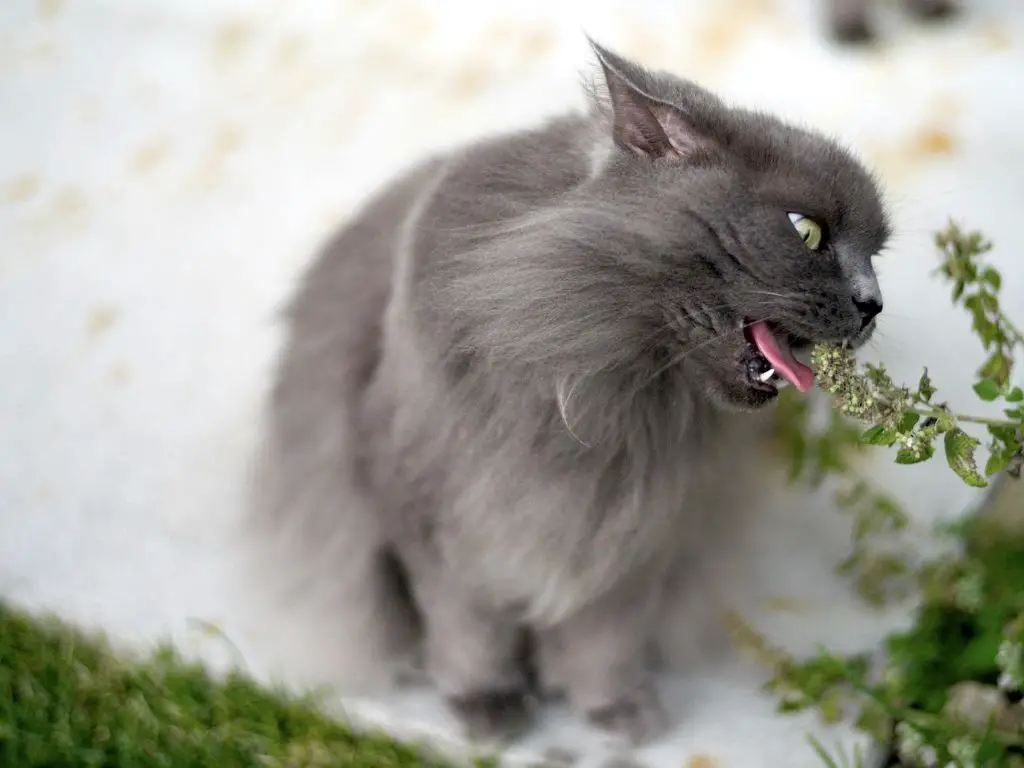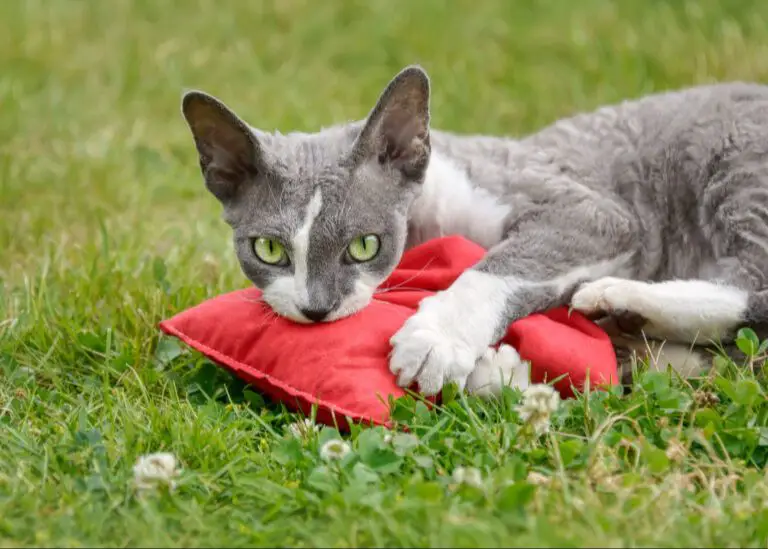Catnip (Nepeta cataria) is a type of mint plant known for its potent effects on cats. The active compound in catnip that attracts cats is called nepetalactone, which is present in the leaves and stems of the plant. Though humans can detect the smell of catnip, the olfactory effects of nepetalactone are much more dramatic for cats.
When cats smell or ingest catnip, most exhibit a temporary euphoric state and display behaviors like rolling, flipping, rubbing, and occasionally aggression. The sensitivity to nepetalactone is an inherited genetic trait, with about 50-70% of cats affected by catnip. But why do some cats react strongly while others seem immune? Understanding catnip’s effects on cats requires looking into the plant’s chemical makeup and feline physiology.
Chemical Composition

The active chemical compound that causes the euphoric response in cats is called nepetalactone. Nepetalactone is an organic compound that belongs to the class of chemicals known as iridoids [1]. It is found in the leaves and stems of catnip plants (Nepeta cataria) as well as other plants in the mint family. Nepetalactone is a bicyclic monoterpenoid compound, meaning it contains two fused rings and is derived from a 10-carbon isoprenoid precursor. Specifically, it contains a cyclopentane ring fused with a six-membered lactone ring [2].
Nepetalactone occurs in two different isomers, which are mirror images of each other. Of these, the (4aS,7S,7aR)-nepetalactone isomer appears to be most attractive to cats. The concentration of nepetalactone in the catnip plant determines the strength of the response it elicits. Typically, levels range from less than 1% up to 4% of the dry weight of the plant [3].
Olfactory Response
Cats detect the key chemical compound in catnip, nepetalactone, through receptors in the olfactory epithelium. This specialized tissue lines the nasal cavity and contains sensory receptor cells that detect odors. When cats inhale air containing catnip, the nepetalactone molecules bind to receptors on these sensory cells, stimulating a response in the olfactory bulb region of the brain.
Research by Hart (1985) explored whether the vomeronasal organ was involved in detecting nepetalactone and triggering the catnip response. The vomeronasal organ is an auxiliary olfactory sense organ located between the roof of the mouth and the nasal septum. However, experiments showed that removal of this organ did not impact cats’ reaction to catnip, indicating the vomeronasal organ is not essential. Nepetalactone appears to be detected solely by olfactory receptors in the nasal epithelium (Hart, 1985).
Behavioral Effects

Catnip induces a range of behavioral effects in cats. The most common behaviors exhibited after exposure to catnip include rolling, flipping, rubbing, and generally zoning out. Cats tend to roll repeatedly on their backs while flipping their legs up in the air. They often rub their head and cheeks on catnip-filled toys or on the ground where dried catnip has been sprinkled. This rubbing response releases more of the aromatic oils that produce the catnip reaction.
Many cats also become hyperactive when given catnip. They may meow or growl while displaying the other typical catnip-induced behaviors. They often playfully chase imaginary objects, pounce on toys, run and jump around the room, and perform other energetic activities. The hyperactivity normally lasts between 5 and 15 minutes before the cat starts to calm down again.
According to PetMD, around 50-66% of cats exhibit a sensitivity to catnip and display these altered behaviors when exposed to it. The behavioral effects tend to last around 5-15 minutes before the cat returns to normal. Most cats need at least 15-30 minutes before reacting to catnip again after the effects have worn off.
Theories on Attraction
There are several theories as to why cats are attracted to catnip. Two of the main theories are the insect repellent theory and the sexual arousal theory. According to the insect repellent theory, catnip contains the chemical compound nepetalactone which is similar to insect repellents found in some plants. When cats sense this compound, it triggers a response that makes them act as if they’re “high” 1. The sexual arousal theory suggests that catnip triggers feline sexual arousal hormones and elicits a response similar to when cats are in heat. Researchers found that cats exposed to catnip demonstrated behaviors like chin rubbing, head shaking, and body rolling that are associated with courtship and mating 2. While the exact mechanism is still being studied, these two theories provide possible explanations for why cats exhibit euphoric, hyperactive behavior when exposed to catnip.
Genetic Predisposition
Not all cats respond to catnip. Researchers estimate that about 50-70% of cats exhibit a response when exposed to catnip [1]. The ability to react to catnip is a genetically inherited trait. Cats that lack the gene responsible for detecting nepetalactone are immune to catnip’s effects [2].
In a 1962 study, researchers found the catnip response was inherited as an autosomal dominant gene. Kittens from parents where both were responsive had a 95% response rate. Kittens with one responsive and one non-responsive parent had a 51% response rate. Kittens from two non-responsive parents had just a 3% response rate [2].
The specific genetics behind the catnip response are not fully mapped out. But the available research clearly demonstrates catnip sensitivity is hereditary and linked to a dominant gene.
Catnip and Wild Cats
Cats are not the only felines to respond to catnip. Many wild cat species also exhibit a range of reactions when exposed to catnip, including lions, tigers, jaguars, leopards, lynxes, and servals. As members of the cat family, they have inherited the genes that cause the catnip response.
Big cats like lions and tigers often react even more strongly to catnip than domestic cats. When given catnip-filled toys, they will excitedly play, roll around, rub against, and sniff at the toys. They also scratch, lick, and at times even try to eat the catnip. Zoos sometimes use catnip to encourage active play in big cats.
Scientists believe the catnip response was evolutionarily advantageous for wild cats, as rolling in and rubbing on the catnip plants caused the release of nepetalactone, which can serve as an insect repellant. Catnip also grows as a weed in areas where cats hunt, so interacting with it regularly could aid their hunting abilities.
Overall, catnip elicits a vigorous reaction in most members of the cat family, from domesticated felines to their larger wild cat counterparts.
Safety
When used appropriately, catnip is considered safe for cats. The active chemical in catnip, called nepetalactone, is non-addictive and does not have any serious side effects (Source). Catnip has a sedating effect on cats when smelled or ingested, rather than a stimulating one. There have been no reported overdoses from catnip exposure. However, some potential side effects of too much catnip include diarrhea, vomiting, and hyperactivity. These effects are temporary and subside once the cat metabolizes the nepetalactone.
Veterinarians recommend using catnip in moderation to avoid any possible adverse reactions. Give your cat access to catnip toys or treats no more than 2-3 times per week. Monitor your cat’s behavior after exposure to ensure proper dosage. Most cats enjoy catnip only occasionally in limited quantities. While intriguing to cats, catnip does not need to be a constant form of entertainment and should be provided sparingly as part of a balanced enrichment routine.
Catnip Alternatives

While catnip is the most well-known plant that attracts cats, there are several alternatives that can also induce euphoric and playful responses.
One popular alternative is valerian (Valeriana officinalis). Valerian contains actinidine, which is chemically similar to the nepetalactone found in catnip and elicits a comparable reaction in cats.[1] When exposed to valerian, most cats will sniff, roll, rub, and even chew on the plant. However, valerian tends to be less popular and potent for cats than catnip.
Other alternatives include silver vine (Actinidia polygama), Tatarian honeysuckle (Lonicera tatarica), and Indian nettle (Coleus canina). These contain compounds like matatabilactone and gelsemine that produce catnip-like effects.[2] Not all cats respond to these plants, but they can be fun alternatives to try for cats that have become desensitized to catnip.
When giving any of these plants to cats, it’s important to provide them fresh or dried and free of pesticides or other chemicals. Start with a small amount and monitor the cat’s reaction. While non-toxic, some cats may become overstimulated.
Conclusion
In summary, cats are attracted to catnip for several key reasons. The nepetalactone in catnip triggers a response in around two-thirds of domestic cats, causing them to exhibit strange yet enjoyable behaviors like rubbing, rolling, and head shaking. While the exact mechanism is still unknown, theories suggest catnip either produces a euphoric effect, mimics feline pheromones, or elicits an instinctual prey drive response. Additionally, some cats may have a genetic predisposition towards the effects of nepetalactone. Whatever the case, catnip provides a safe and effective way to enrich a cat’s environment and bring them joy. The unique reaction felines have to this aromatic herb continues to captivate cat lovers and science alike.
